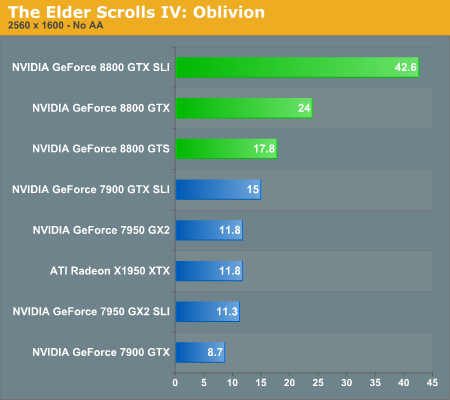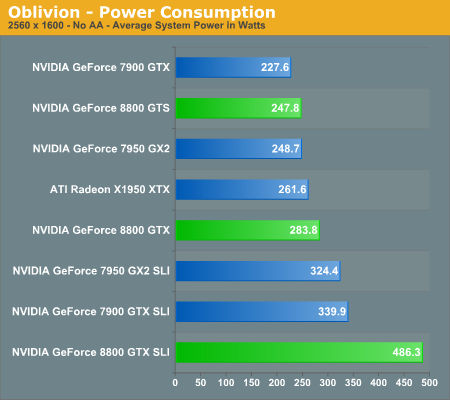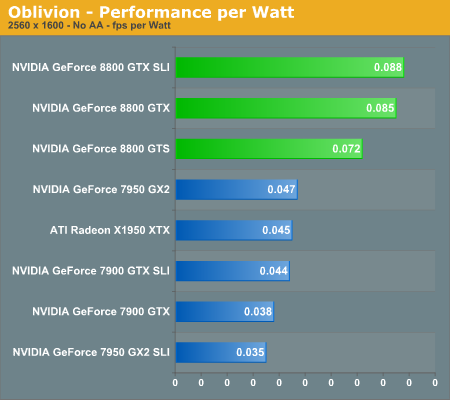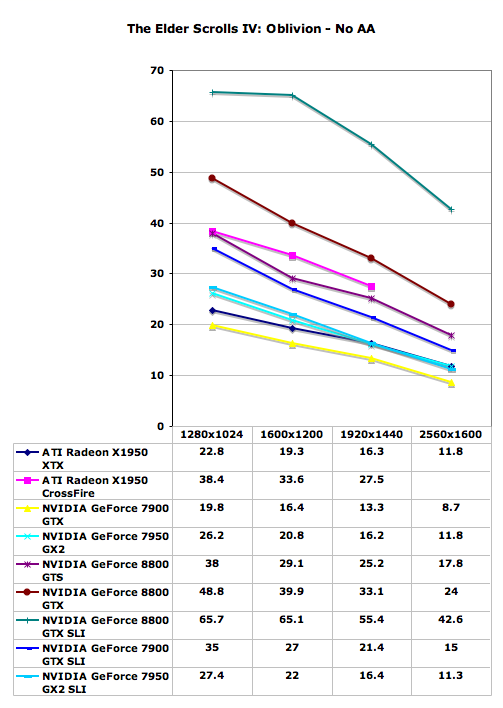NVIDIA's GeForce 8800 (G80): GPUs Re-architected for DirectX 10
by Anand Lal Shimpi & Derek Wilson on November 8, 2006 6:01 PM EST- Posted in
- GPUs
Oblivion Performance
We aren't listing the table with all the settings we used because this time it's easy. We cranked everything up to the maximum setting. Every slider maxed and every feature enabled (with the exception of bloom and AA which are precluded by HDR). Taking into account just how stressful this game is under balanced quality settings, we can easily see just how incredible the 8800 GTX really is.




Oblivion has been one of the most demanding games in terms of graphics requirements ever since its launch. Up till now, ATI had a pretty substantial performance lead over almost anything NVIDIA could offer in this game, short of the 7950 GX2. With the launch of the GeForce 8800 series, the tables have turned, and quite dramatically. Not only does a single 8800 GTX card outperform any other current configuration (with the likely exception of 8800 GTS SLI, which we weren't able to test yet), but even the GeForce 8800 GTS is able to perform nearly as fast as X1950 XTX CrossFire, and slightly better than 7900 GTX SLI.
The 8800 GTX SLI is still the bottleneck in this game at resolutions above 1280x1024, showing just how demanding Oblivion is when it comes to graphics cards. ATI's CrossFire also scales better than NVIDIA's SLI in this title, gaining on average ~75% with CrossFire versus ~65% with SLI. Of course, we have to temper that statement by pointing out that X1950 CrossFire did not run properly at 2560x1600.










111 Comments
View All Comments
aweigh - Friday, November 10, 2006 - link
You can just use the program DX Tweaker to enable Triple Buffering in any D3D game and use your VSYNC with negligable performance impact. So you can play with your VSYNC, a high-res and AA as well. :)aweigh - Friday, November 10, 2006 - link
I'm gonna buy an 88 specifically to use 4x4 SuperSampling in games. Why bother with MSAA with a card like that?DerekWilson - Friday, November 10, 2006 - link
Supersampling can make textures blurry -- especially very detailed textures.And the impact will be much greater with the use of longer more detailed pixel shaders (as the shaders must be evaluated at every sub-pixel in supersample).
I think transparency / adaptive AA are enough.
On your previous comment, I don't think we're to the point where we can hit triple buffering, vsync, high levels of AA AND high resolution (2560x1600) without some input lag (triple buffering plus vsync with framerates less than your refresh rate can cause problems).
If you're talking about enabling all these options on a lower resolution lcd panel, then I can definitely see that as a good use of the hardware. And it might be interesting to look at more numbers with these type of options enabled.
Thanks for the suggestion.
aweigh - Saturday, November 11, 2006 - link
I never knew that about SuperSampling. Is it something similar to Quincux blurring? And would using a negative LOD via RivaTuner/nHancer counteract the effect?How about NVIDIA's Digital Sharpness setting in Color Correction? I've found a smidge of sharpening can do wonders to improve overall clarity.
By the way, when you said Adaptive AA, were you referring to ATI cards?
Unam - Friday, November 10, 2006 - link
Derek,Saw your comment regarding the rationale for the test resolution, while I understand your reasoning now, it still begs the question how many of your readers have 30" LCD flat panels?
DerekWilson - Friday, November 10, 2006 - link
There might not be many out there right now, but it's still the right test platform for G80. We did test down to 1600x1200, so people do have information if they need it.But it speaks to who should own an 8800 GTX right now. It doesn't make sense to spend that much money on a part if you aren't going to get anything out of it with your 1280x1024 panel.
Owners of a 2560x1600 panel will want an 8800 GTX. Owners of an 8800 GTX will want a 2560x1600 panel. Smooth framerates with the ability to enable 4xAA in every game that allowed it is reason enough. People without a 2560x1600 panel should probably wait until prices come down on the 8800 GTX or until games that are able to push the 8800 GTX harder to buy the card.
Unam - Tuesday, November 14, 2006 - link
Derek,A follow up to testing resolutions, the FPS numbers we see in your articles, are they maximum, minimum or average?
Unam - Friday, November 10, 2006 - link
Who the heck runs 2560x1600? At 4XAA? Come on guys, real world benchmarks please!DerekWilson - Friday, November 10, 2006 - link
we did:1600x1200, 1920x1440, and even 1280x1024 in Oblivion
dragonsqrrl - Thursday, August 25, 2011 - link
....lol, owned.